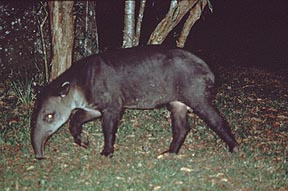Baird's Tapir
Here’s an animal you don't see everywhere, but you can see it during your vacation —Baird’s Tapir (Tapirus bairdii) Spanish Name: Danto, Danta.

More about Bairds Tapir
Habitat
This tapir survives in dry deciduous forest and tropical evergreen forest and other habitats.
Range
This species of tapir can be found from Veracruz, Mexico down to Ecuador.
Physical Description
Baird's Tapir is the largest of three South American tapir species; there is another tapir in the South America lowlands, Tapirus terrestris; in the mountains of South America resides the smaller, furrier tapir, Tapirus roulinil; one other tapir which is black and white exists in peninsular Malaysia, Tapirus indicus.
Adult tapirs have short sparse black hair over leathery black skin. Their skin is really tough-1 to 3 cm thick! Juveniles will be brown with white spots and stripes. The tapir has a short tail and a long flexible upper lip, with which it picks leaves and pushes food into its mouth.
Biology and Natural History
Tapirs have incredibly strong dentate molars for grinding hard seeds and tough plant material. They are particular about what and how much they eat of certain plants. It has been noticed that tapirs prefer to defecate in water or repeatedly in the same place on land, most likely to reduce their trail to predators.
The endangered tapir is the largest indigenous terrestrial mammal in Central America. Perhaps due to previous heavy hunting, the tapir has become extremely shy, covert, and evasive. Their behavior is crepuscular, meaning they are active at dusk and early morning, but they have also been known to be active at night. They can smell and hear quite acutely, compensating for their poor eyesight. They use routine trails to and from wallowing and feeding sites – which can make them vulnerable to hunters. If they are startled, they can run as fast as a human on their short, powerful legs. Considering their size, they can move surprisingly quietly even over muddy forest floors because their toes come together when they lift up their feet.
The tapir used to be common in all kinds of habitat in Central America; but that all changed once guns were introduced to the area. Now they are mostly found in national parks, and their numbers are still recovering from past hunting.
Adult tapirs live independently except when a female is raising her young. Females have one baby at a time, which stays with her for a year, at which point it will be about two-thirds of her weight. The baby is camouflaged by its spots and stripes so it is safe hiding while it waits for its mother to come back and nurse it. It will start following the mother at 10 days old. Mothers are aggressively defensive of their young, and in the past have attacked humans for this reason. However, they can become docile around other animals. In captivity, peccaries were seen picking ticks off of a tapir and eating them, and coatis have done this to tapirs in the wild as well. Coatis and peccaries perform such mutual grooming in the wild, but the tapir does not. In these observed instances, the tapir did not return the favor, but did not seem to mind their contact, either.
Diet
The tapir mostly eats leaves, twigs, fruits, and some seeds. It is an important disperser of seeds for several plants (e.g., Raphia faedigera).
Height/Weight
An adult tapir weighs 150 to 300 kg.
Taxonomy
Order: Perissodactyla
Family: Tapiridae
Sources
Eisenberg, John. Mammals of the Neotropics, Vol. 1. The University of Chicago Press: Chicago, 1989.
Janzen, Daniel H. Costa Rican Natural History. Chicago: University of Chicago Press, 1983.
Wilson, D. E. in Janzen, Daniel H. Costa Rican Natural History. Chicago: University of Chicago Press, 1983.
-Amy Strieter, Wildlife Writer
Bairds Tapir Sightings
Similar Profiles
We believe travel is more than ticking destinations off a list – it’s about discovering new places deeply, feeling connected wherever you go, and knowing you have a trusted team behind you every step of the way.



